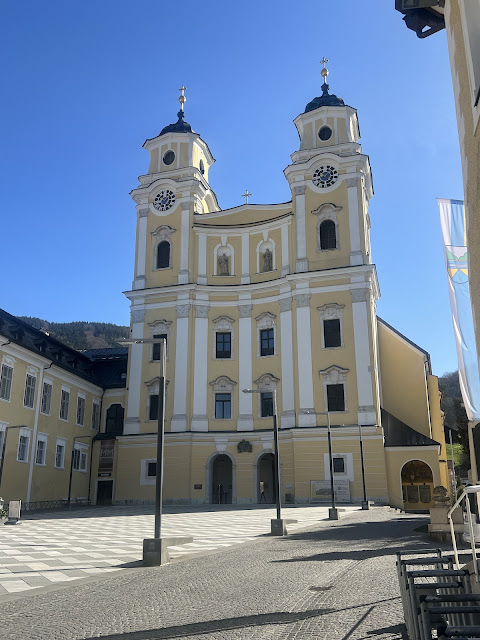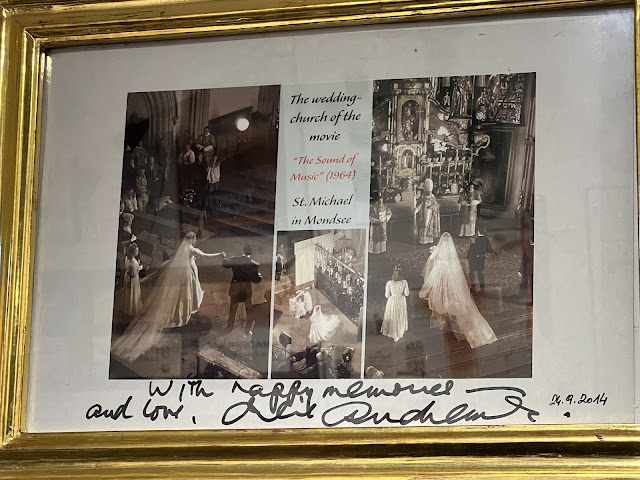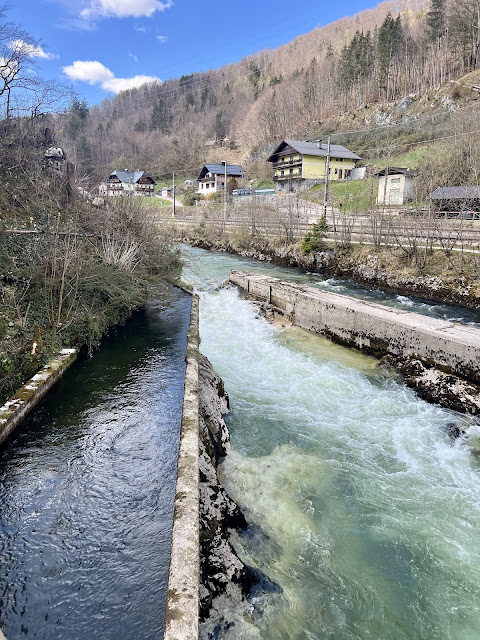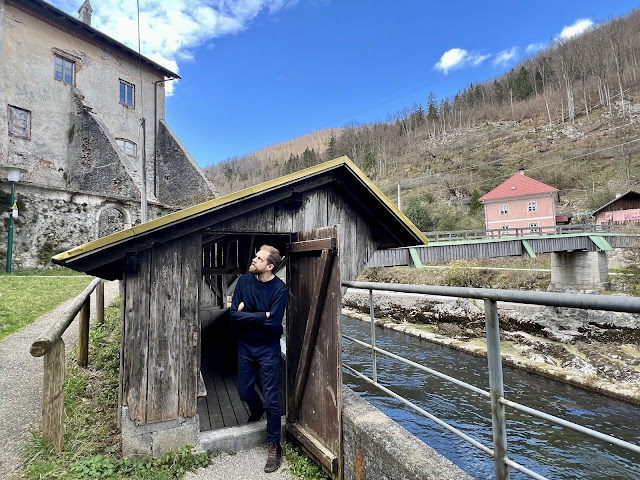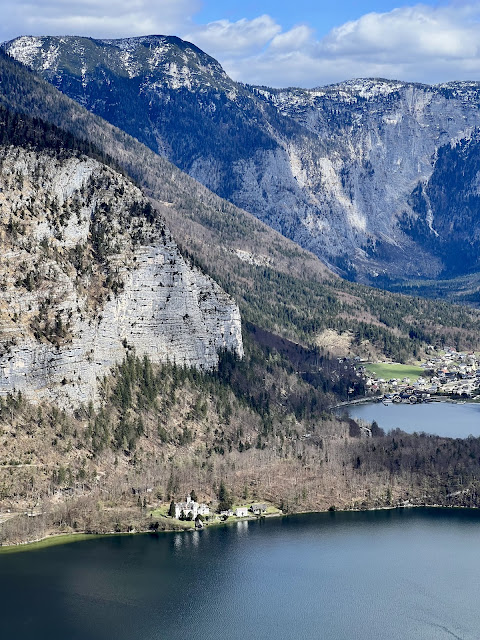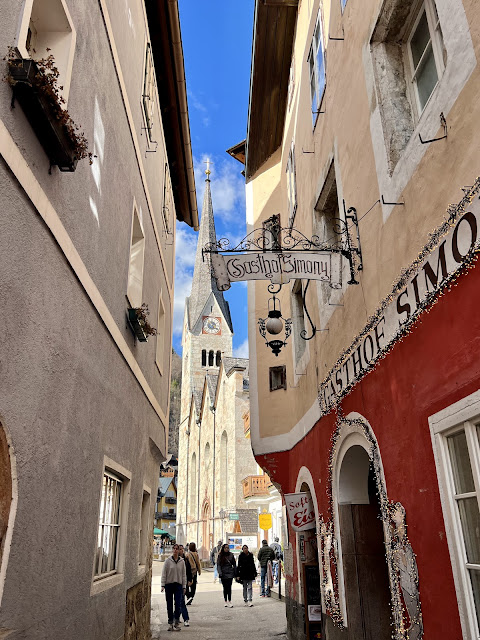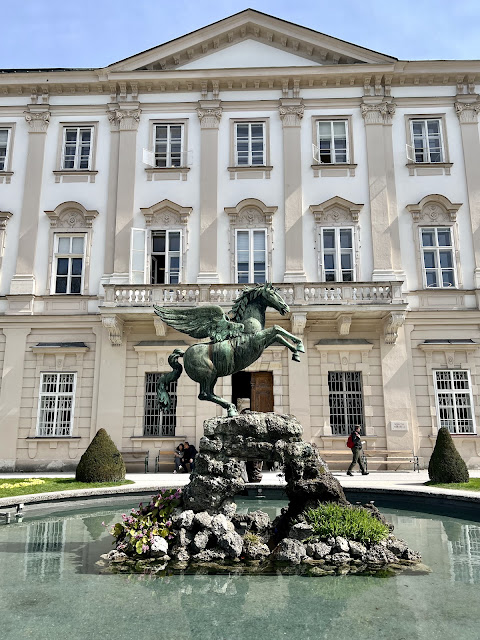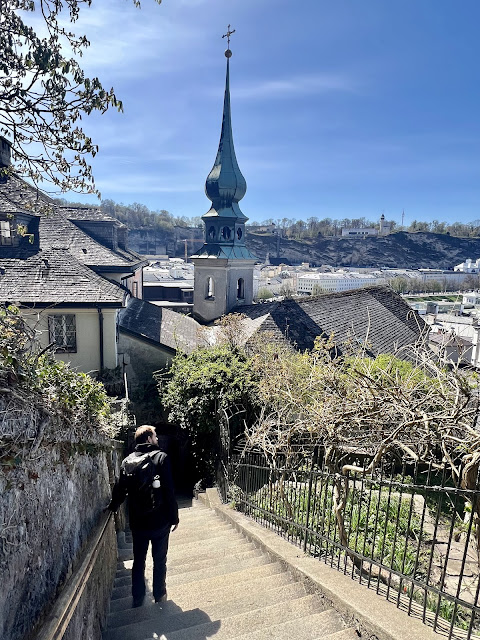After another fairytale breakfast in our guesthouse, we hit the road to explore the lake district around us. There was a larger lake up the hill, so we headed that way to check it out. We drove around the lake through charming little villages, taking in the majestic views. At the far end of the lake, we entered a larger town with a lakeside promenade and some beautiful churches. It was about time for our next coffee of the day, so we decided to stop and explore.
Mondsee was quiet, cute, and not touristy at all. We found a warm little café full of locals, where I spotted a pretzel holder on the wall filled with pretzels. My kind of place! Sitting in that quaint bakery ambiance with my cappuccino is when I feel the most European. After our coffees, we strolled over to the church, not expecting much—but we were blown away. Built in the year 788, it was over 1,100 years old! The church was ornate, heavy, and dark, filled with intricate details and a few notable relics, including the molar teeth of 10th-century Saint Wolfgang.
To our surprise, as we exited through the tiny gift shop, we noticed a signed photograph of Julie Andrews. It turned out that this was the very church where the wedding scene from The Sound of Music was filmed in 1964! Julie Andrews had returned in 2014, and we saw another signed photo from that visit. We keep stumbling upon these amazing sights!
After our time in Mondsee, we returned to our little hamlet across the road from the monastery, just in time to attend the morning meditation with the monks and Brother David. Although Brother David is a Benedictine monk, he also spent years in Zen Buddhist monasteries. At one point, he spent five days sitting in silence from 4:30 a.m. to 9 p.m. each day at a monastery in Big Sur, California. He brought that deep meditative practice into the Benedictine tradition, and now their monastic life includes silent meditation with a bell, in addition to the daily services.
We didn’t meditate for five days, but we did join Brother David and the monks for a beautiful half-hour session. It was deeply special and, as always, helped me bring awareness to my mind, spirit, and connection with God.
Afterward, it was time for an adventure! We really wanted to visit the salt mines—I’ve heard stories about my grandparents’ visit to Salzburg for years, especially their time in the salt mines. There were two options: Salzburg or Hallstatt. Since Hallstatt had been on my wish list ever since I saw a stunning image of it years ago, we chose to go there.
We made the scenic drive through the Alps, the landscape becoming more dramatic with every kilometer. We stopped in a tiny town nestled beside a gorgeous green-blue mountain river. The town was old and mostly empty. Judging by the still-operational canal and waterworks, there must have once been a large water mill. We climbed ancient staircases that led us to a tiny square and stepped into yet another historic church, this one dedicated to Mother Mary.
Next to the church was a pristine, quiet café—so very Austrian. We sat in the sun with more coffee and pastries, taking it all in. Then, it was onward to Hallstatt.
We arrived at the Salt Mine, but the ticket price just to take the funicular up the mountain was already steep, so we decided to skip the tour and simply ride up for the view. We had no idea what was awaiting us.
As we reached the top, we were greeted by a view so stunning it felt like heaven. We stood high above the lake, looking down on Hallstatt and the neighboring villages dotted around the water. We breathed in the crisp mountain air and took in the sweeping panorama.
Apparently, prehistoric people lived in this area from the 12th to the 9th century BC, during the Late Bronze Age. They buried their dead in the shadowy slopes of the mountains, and in 1846, the first archaeological discoveries were unearthed. Along the hiking trail, we encountered an exhibit explaining their burial sites and showcasing some of the ancient metalwork they had created.
And of course, this being Europe, there was a café at the top of the mountain! We got an incredible table and enjoyed some Hefeweizen and French fries while listening to a medley of languages around us. Below, tiny boats made their way across the lake, and the mountains surrounded us like massive, impenetrable walls of stone.
Eventually, we descended into the town of Hallstatt itself—the most touristy place we’ve visited so far, but for good reason. It was gorgeous! We learned that after Easter, this region gets much busier, so we had timed our visit perfectly. The town was stunning: ancient buildings nestled right up to the lake’s edge.
We wandered up winding stone stairs to the church and peeked inside. Several cats wandered the walkways, soaking up the sun. The whole place felt peaceful and timeless. I hadn’t been sure we’d get to visit Hallstatt on this trip, so I feel incredibly fortunate that we did. And ironically, it was our search for the Salt Mine—even though we didn’t go in—that led us to one of the most breathtaking views we’ve ever seen.
Keeping our expectations low and avoiding over-planning gave us so much space to be surprised, to feel grateful, and to experience the magic of the moment. We are so grateful.


